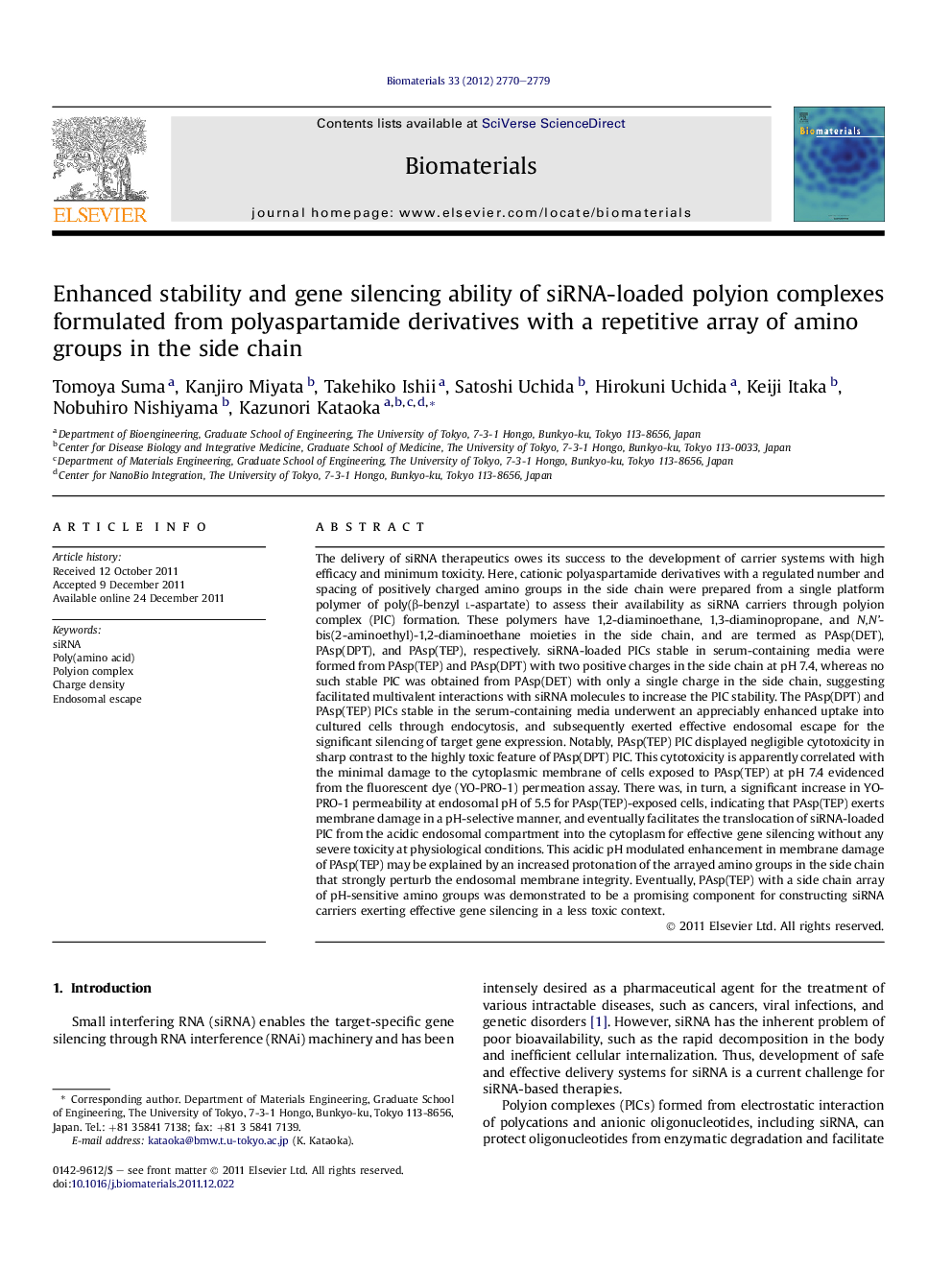| کد مقاله | کد نشریه | سال انتشار | مقاله انگلیسی | نسخه تمام متن |
|---|---|---|---|---|
| 10229405 | 531 | 2012 | 10 صفحه PDF | دانلود رایگان |
عنوان انگلیسی مقاله ISI
Enhanced stability and gene silencing ability of siRNA-loaded polyion complexes formulated from polyaspartamide derivatives with a repetitive array of amino groups in the side chain
دانلود مقاله + سفارش ترجمه
دانلود مقاله ISI انگلیسی
رایگان برای ایرانیان
کلمات کلیدی
موضوعات مرتبط
مهندسی و علوم پایه
مهندسی شیمی
بیو مهندسی (مهندسی زیستی)
پیش نمایش صفحه اول مقاله

چکیده انگلیسی
The delivery of siRNA therapeutics owes its success to the development of carrier systems with high efficacy and minimum toxicity. Here, cationic polyaspartamide derivatives with a regulated number and spacing of positively charged amino groups in the side chain were prepared from a single platform polymer of poly(β-benzyl l-aspartate) to assess their availability as siRNA carriers through polyion complex (PIC) formation. These polymers have 1,2-diaminoethane, 1,3-diaminopropane, and N,N'-bis(2-aminoethyl)-1,2-diaminoethane moieties in the side chain, and are termed as PAsp(DET), PAsp(DPT), and PAsp(TEP), respectively. siRNA-loaded PICs stable in serum-containing media were formed from PAsp(TEP) and PAsp(DPT) with two positive charges in the side chain at pH 7.4, whereas no such stable PIC was obtained from PAsp(DET) with only a single charge in the side chain, suggesting facilitated multivalent interactions with siRNA molecules to increase the PIC stability. The PAsp(DPT) and PAsp(TEP) PICs stable in the serum-containing media underwent an appreciably enhanced uptake into cultured cells through endocytosis, and subsequently exerted effective endosomal escape for the significant silencing of target gene expression. Notably, PAsp(TEP) PIC displayed negligible cytotoxicity in sharp contrast to the highly toxic feature of PAsp(DPT) PIC. This cytotoxicity is apparently correlated with the minimal damage to the cytoplasmic membrane of cells exposed to PAsp(TEP) at pH 7.4 evidenced from the fluorescent dye (YO-PRO-1) permeation assay. There was, in turn, a significant increase in YO-PRO-1 permeability at endosomal pH of 5.5 for PAsp(TEP)-exposed cells, indicating that PAsp(TEP) exerts membrane damage in a pH-selective manner, and eventually facilitates the translocation of siRNA-loaded PIC from the acidic endosomal compartment into the cytoplasm for effective gene silencing without any severe toxicity at physiological conditions. This acidic pH modulated enhancement in membrane damage of PAsp(TEP) may be explained by an increased protonation of the arrayed amino groups in the side chain that strongly perturb the endosomal membrane integrity. Eventually, PAsp(TEP) with a side chain array of pH-sensitive amino groups was demonstrated to be a promising component for constructing siRNA carriers exerting effective gene silencing in a less toxic context.
ناشر
Database: Elsevier - ScienceDirect (ساینس دایرکت)
Journal: Biomaterials - Volume 33, Issue 9, March 2012, Pages 2770-2779
Journal: Biomaterials - Volume 33, Issue 9, March 2012, Pages 2770-2779
نویسندگان
Tomoya Suma, Kanjiro Miyata, Takehiko Ishii, Satoshi Uchida, Hirokuni Uchida, Keiji Itaka, Nobuhiro Nishiyama, Kazunori Kataoka,